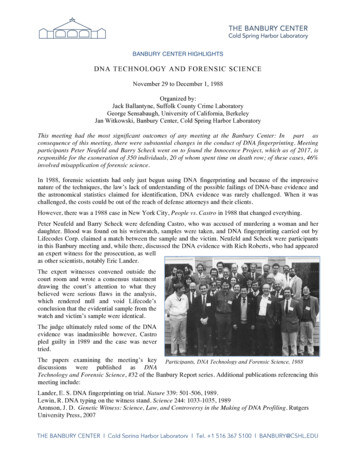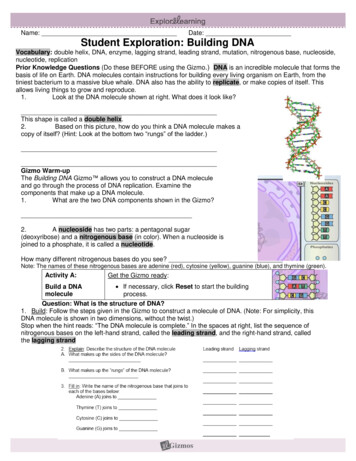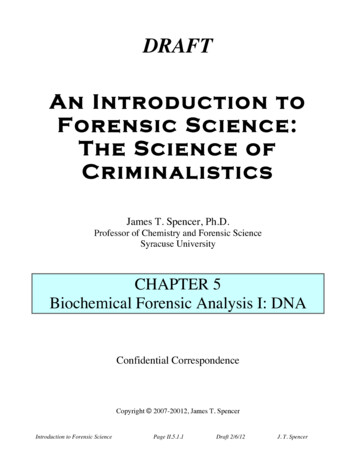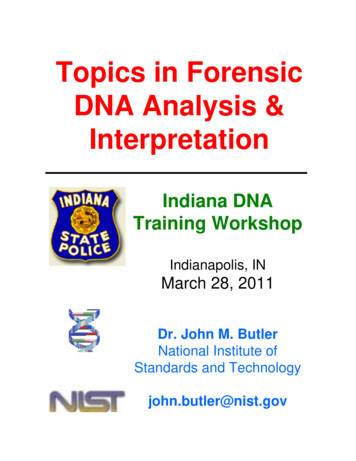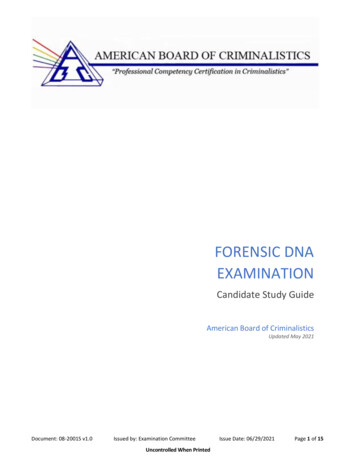
Transcription
FORENSIC DNAEXAMINATIONCandidate Study GuideAmerican Board of CriminalisticsUpdated May 2021Document: 08-2001S v1.0Issued by: Examination CommitteeUncontrolled When PrintedIssue Date: 06/29/2021Page 1 of 15
American Board of CriminalisticsForensic DNA ExaminationCandidate Study GuideTable of ContentsIntroduction . .3Examination Outline . 4Science and Math . 5Process (DNA) . 6Computer . 6Quality Assurance/Quality Control . 7Laboratory . 7Communication . 8Legal . 8Forensic Disciplines . 8References . 9Example Questions . 11Example Questions Key. 15Document:08-2001S v1.0Issued by: Examination CommitteeUncontrolled When PrintedIssue Date: 06/29/2021Page 2 of 15
American Board of CriminalisticsForensic DNA ExaminationCandidate Study GuideIntroductionCongratulations on your decision to pursue certification!This examination was created through the Developing a Curriculum (DACUM) process. Using a panel ofSubject Matter Experts (SME), a job analysis was completed to define the profession of ForensicBiology. As a result of this job analysis, two separate job classifications were generated – BiologicalEvidence Screener and Forensic DNA Analyst. The Forensic DNA Analyst Job Description (08-1001S) wascreated and lists the duties and associated tasks for that position. The SME was comprised ofpractitioners from a variety of types of laboratories (e.g., city/county, state, federal, etc.) across thecountry. The tasks and duties in the job description may include ones that are not performedspecifically by your Forensic Science Service Provider but are part of the larger role of a Forensic DNAAnalyst.The tasks listed in the job description were aligned to Knowledge-Skill (K-S) categories, and thesecategories were grouped into larger Domains (e.g., Science and Math, Quality Assurance/QualityControl, etc.) to create the Forensic DNA Examination Blueprint. This blueprint was subsequently usedto determine the number of questions in each of the larger domains.The examination is structured around the knowledge and skills needed to perform tasks and duties ofthe job. The study guide was developed using the job description and the examination blueprint. All K-Scategories are represented in the examination. Refer to the Forensic DNA Examination Blueprint for adetailed breakdown of the Knowledge/Skills and Tasks used to create this examination.References listed in this Study Guide were used to write examination questions; however, not allquestions were written using these references.For more information on the development of this examination, please refer to additional examinationdevelopment documents on the ABC website.Document:08-2001S v1.0Issued by: Examination CommitteeUncontrolled When PrintedIssue Date: 06/29/2021Page 3 of 15
American Board of CriminalisticsForensic DNA ExaminationCandidate Study GuideExamination OutlineDomainKnowledge-Skill% of ExamScience and Math42%Biology (e.g., molecular, cellular)ChemistryGeneticsPopulation GeneticsStatisticsMathProcess (DNA)19%Organizational (e.g., time management, multi-tasking)Critical thinking (e.g., analytical, decision making, problemsolving)Scientific methodComputer12%ComputerLIMSCODISQuality Assurance/Quality Control9%ISO 17025 / ANABQASSWGDAMLaboratory8%Good laboratory practice (e.g., safety, PPE)Laboratory skills (e.g., pipetting, robotics)Communication5%Communication (e.g., oral, written, presentation, listening,interpersonal)Legal3%Legal systemForensic Disciplines2%Other forensic disciplinesDocument:08-2001S v1.0Issued by: Examination CommitteeUncontrolled When PrintedIssue Date: 06/29/2021Page 4 of 15
American Board of CriminalisticsForensic DNA ExaminationCandidate Study GuideScience and MathThe Science and Math domain makes up 42% of the examination. The knowledge and skills needed tosucceed in this domain are: Scientific concepts in the field of biologyo Biochemistryo Cell structureo DNA (e.g., nuclear, mitochondrial, Y-chromosome)o Geneticso Molecular biology Cell and DNA morphology, process, and structureScientific concepts in the field of chemistryo Scientific unitso Scientific nomenclatureo Basic definitions of scientific concepts (e.g., chemicals, molecules, solutions, etc.)Scientific concepts in the field of geneticso Inheritanceo Gene mutationo Kinship analysisScientific concepts in the field of population geneticso Hardy-Weinberg equilibriumo Allele, genotype, and haplotype frequencyo Mutation, natural selection, genetic drift, migration/gene flowMathematical concepts and their application to the fields of biology and chemistryo Dilutionso Basic calculations and SI unit conversionsStatistical definitions and conceptso Mean, median, mode, etc.o Confidence interval, standard deviation, and variabilityo Bayesian theoryo Random match probability, CPI/CPE, likelihood ratio, and probabilistic genotypingo Binary, semi-continuous, and fully continuous methodso Kinship analysisDocument:08-2001S v1.0Issued by: Examination CommitteeUncontrolled When PrintedIssue Date: 06/29/2021Page 5 of 15
American Board of CriminalisticsForensic DNA ExaminationCandidate Study GuideProcess (DNA)The Process (DNA) domain makes up 19% of the examination. The knowledge and skills needed tosucceed in this domain are: Organizationalo Testing planso Technical and administrative reviewso Recommendations, guidelines, and best practices from national and internationalorganizations (e.g., ANAB, ASB, ASTM, FBI, NIJ, NIST, OSAC, SWGDAM, etc.)Critical thinkingo Sample collection for forensic DNA analysiso DNA analysis procedures (e. g., extraction, quantitation, amplification, typing, andinterpretation)o Mixture deconvolutiono CODIS searchingScientific methodo Types of evidence and methods of transfero Handling and storage of evidenceo Analysis of evidence, including order of analysis for evidence with multiple disciplinesrequestedo Sample collection from evidence, especially for downstream processingo Adequate note takingo Interpretation of resultso Report writingComputerThe Computer domain makes up 12% of the examination. The knowledge and skills needed to succeedin this domain are: Use of computer software in forensic scienceo Documentation and analysis of evidenceo Proficiency testingo Draft and final reportso Court testimonyUse of LIMS in forensic DNA analysiso Maintaining chain of custodyo Inventory, documentation, and analysis of evidence, samples, etc.o SecurityCODISo Data eligibility and suitability requirementso Searching and NDIS operational proceduresDocument:08-2001S v1.0Issued by: Examination CommitteeUncontrolled When PrintedIssue Date: 06/29/2021Page 6 of 15
American Board of CriminalisticsForensic DNA ExaminationCandidate Study GuideQuality Assurance/Quality ControlThe Quality Assurance/Quality Control domain makes up 9% of the examination. The knowledge andskills needed to succeed in this domain are: Quality assurance and quality control in the crime laboratoryo Validation and verificationo Different types of controls, performance checkso Training programso Note takingo Report writingo Technical and administrative reviewso Proficiency testingo Expert testimonyISO Accreditationo ISO/IEC 17025 and AR 3125 standards and accreditation requirementso Accreditation processo Guiding Principles of Professional ResponsibilityQuality Assurance Standards (QAS)o FBI Quality Assurance Standards for DNA Databasing Laboratorieso FBI Quality Assurance Standards for DNA Testing Laboratorieso The Guidance Document for the FBI Quality Assurance Standards for Forensic DNATesting and DNA Databasing LaboratoriesScientific Working Group on DNA Analysis Methods (SWGDAM)o Recommendations, guidelines, and best practicesLaboratoryThe Laboratory domain makes up 8% of the examination. The knowledge and skills needed to succeedin this domain are: Basic concepts in good laboratory practiceo Communication of laboratory safety procedureso Proper Personal Protective Equipment (PPE) in the laboratoryBasic laboratory skillso Proper use of laboratory glassware, pipettes, and other measuring deviceso Contamination prevention procedureso Purpose and basic theory of equipment commonly used for forensic DNA analysiso Sample collection from evidence through DNA sample processingDocument:08-2001S v1.0Issued by: Examination CommitteeUncontrolled When PrintedIssue Date: 06/29/2021Page 7 of 15
American Board of CriminalisticsForensic DNA ExaminationCandidate Study GuideCommunicationThe Communication domain makes up 5% of the examination. The knowledge and skills needed tosucceed in this domain are: Ways to effectively communicate in forensic scienceo Technical and administrative documentationo Adequate note takingo Writing and reviewing reportso Courtroom testimonyo Communication between the laboratory and the customerLegalThe Legal domain makes up 3% of the examination. The knowledge and skills needed to succeed in thisdomain are: Case file documentation for legal proceedings (e.g., administrative, technical, supporting, etc.)Knowledge of proper expert testimonyBasic understanding of the Federal rules of evidenceUnderstanding the difference between Daubert and FryeBasic understanding of different types of warrants, subpoenas, etc.Court cases important to the field of forensic evidenceForensic DisciplinesThe Forensic Disciplines domain makes up 2% of the examination. The knowledge and skills needed tosucceed in this domain are: Basic knowledge of different types of forensic evidenceBasic knowledge of common forensic analyses performed on different types of evidenceCollection of samples from evidencePreservation of evidence for testing in other disciplinesCoordination of testing with other disciplinesDocument:08-2001S v1.0Issued by: Examination CommitteeUncontrolled When PrintedIssue Date: 06/29/2021Page 8 of 15
American Board of CriminalisticsForensic DNA ExaminationCandidate Study GuideReferencesGeneral College Textbooks (or similar)EditionAuthor Molecular Biology of the CellCampbell BiologyGenetics from Genes to GenomesLehninger Principles of Biochemistry6th11th5th7th General Chemistry Principles andModern Applications7thAlberts, Bruce, et al.Campbell, Neil A.Hartwell, Leland H., et al.Nelson, David L. andCox, Michael M.Petrucci, Ralph H. andHarwood, William S.Forensic DNA Typing - Butler SeriesEditionAuthor Forensic DNA Typing2ndButler, John M. Fundamentals of Forensic DNA Typing3rdButler, John M. Advanced Topics in Forensic DNA Typing:Methodology Advanced Topics in Forensic DNA Typing:Interpretation3rdButler, John M.3rdButler, John M.Other Forensic Science BooksEditionAuthor Forensic Chemistry Forensic DNA Evidence Interpretation2ndBell, Suzanne2ndBuckleton, J., Bright, J.,and Taylor. D. Forensic Practitioner’s Guide to theInterpretation of Complex DNA Profiles Fundamentals of Forensic Science1stGill, Peter, et al.2nd or later Houck, M. and Siegel, J. Criminalistics: An Introduction to Forensic Science 7th or later Saferstein, R. Forensic Science Handbook, Volume I2ndSaferstein, R. Forensic Science Handbook, Volume II2ndSaferstein, R.Guidance/Standards DocumentsEditionAuthor Rules of Professional ConductABC ISO/IEC 17025: General Requirements for theCompetence of Testing and CalibrationLaboratoriesDocument:08-2001S v1.02017Issued by: Examination CommitteeUncontrolled When PrintedISO/IECIssue Date: 06/29/2021Page 9 of 15
American Board of CriminalisticsForensic DNA ExaminationCandidate Study Guide AR 3125 ISO/IEC 17025: Forensic Science Testingand Calibration Laboratories AccreditationRequirements2019ANSI NationalAccreditation Board Quality Assurance Standards for Forensic DNATesting Laboratories2011 andlaterFederal Bureau ofInvestigation Quality Assurance Standards for DNA DatabasingLaboratories2011 andlaterFederal Bureau ofInvestigation National Best Practices for Sexual Assault Kits:A Multidisciplinary Approach The Biological Evidence Preservation Handbook:Best Practices for Evidence HandlersNational Institute ofJusticeNISTIR7928Ballou et. al.SWGDAM Publications (or similar, more recent) Contamination Prevention and Detection Guidelines for Forensic DNA Laboratories (2017) Guidelines for the Collection and Serological Examination of Biological Evidence (2015) Guidelines for Missing Persons Casework (2014) Guidelines for STR Enhanced Detection Methods (2014) Guidelines for the Validation of Probabilistic Genotyping Systems (2015) Interpretation Guidelines for Autosomal STR Typing by Forensic DNA Testing Laboratories (2017)and Addendum (2019) Y-chromosome Short Tandem Repeat (Y-STR) Interpretation Guidelines (2009) Interpretation Guidelines for Y-Chromosome STR Testing (2014) Mitochondrial DNA Analysis Interpretation Guidelines (2019) Mitochondrial DNA Nomenclature Examples (2014) Recommendations for the Efficient DNA Processing of Sexual Assault Evidence Kits (2016) The Guidance Document for the FBI Quality Assurance Standards for Forensic DNA Testing and DNADatabasing Laboratories (2020) Training Guidelines (2020) Validation Guidelines for Forensic DNA Analysis Methods (2016)Document:08-2001S v1.0Issued by: Examination CommitteeUncontrolled When PrintedIssue Date: 06/29/2021Page 10 of 15
American Board of CriminalisticsForensic DNA ExaminationCandidate Study GuideExample QuestionsBelow are 10 questions that represent the structure of questions on the examination. The primaryKnowledge-Skill (K-S) Category and Associated Job Task(s) are also included. Refer to the Introductionfor additional information regarding K-S and Job Tasks.Knowledge-Skill: 1.4 – Population GeneticsJob Task: D8 – Calculate sample statistics (e.g., RMP, LR, counting method)1. When a population’s alleles at the same locus are inherited independently of one another, thepopulation is said to be in what type of equilibrium?A.B.C.D.HomeostaticRelative InheritanceLinkageHardy-WeinbergKnowledge-Skill: 1.1 – BiologyJob Task: D2 – Assess quality of DNA typing samples2. Which of the following BEST describes a centiMorgan (cM)?A.B.C.D.A distance of 50 centiMorgans equals a recombination factor of 0.5.A centiMorgan is a unit of measure used to relate distance between two loci.A distance of 25 centiMorgans is sufficient to assure independence.A centiMorgan is a unit of measure used to relate distance between two alleles withinthe same locus.Knowledge-Skill: 1.6 – MathJob Task: D8 – Calculate sample statistics (e.g., RMP, LR, counting method)3. Events that occur with no effect on the probability of each other occurring are considered:A.B.C.D.mutually exclusive.mutually 1S v1.0Issued by: Examination CommitteeUncontrolled When PrintedIssue Date: 06/29/2021Page 11 of 15
American Board of CriminalisticsForensic DNA ExaminationCandidate Study GuideKnowledge-Skill: 5.2 Critical Thinking (e.g., analytical, decision making, problem solving)Job Tasks: D2 – Assess quality of DNA typing samplesD4 – Eliminate DNA process artifactsD6 – Deduce contributorsD7 – Compare DNA contributors (e.g., knowns, evidentiary samples)D8 – Calculate sample statistics (e.g., RMP, LR, counting method)4. Please order the following steps for the MOST reasonable approach to draw conclusions from a 2person DNA mixture:1)2)3)4)5)A.B.C.D.Compare genotype profiles with reference samplesDetermine approximate ratio of the components in the mixtureIdentify artifacts versus allelesPerform statistical analysisIdentify the number of contributors to the mixture1, 2, 3, 5, 45, 2, 3, 1, 41, 5, 3, 4, 23, 5, 2, 1, 4Knowledge-Skill: 5.2 – Critical ThinkingJob Task: D4 – Eliminate DNA process artifacts5. Which of the following is a PCR-induced artifact?A.B.C.D.stutterpull-upspikeelevated baselineDocument:08-2001S v1.0Issued by: Examination CommitteeUncontrolled When PrintedIssue Date: 06/29/2021Page 12 of 15
American Board of CriminalisticsForensic DNA ExaminationCandidate Study GuideKnowledge-Skill: 5.2 – Critical Thinking (e.g., Analytical, Decision Making, Problem-solving)Job Task: D1 – Assess quality of DNA typing6. A sample whose concentration meets the threshold for PCR was amplified and typed. Uponevaluating STR results from the CE, acceptable allelic ladders were observed but no peaks weredetected in the evidence samples or the positive amplification/PCR control. What is the most likelyexplanation?A. A PCR inhibitor was present in the amplification master mix.B. No DNA was present in the evidence sample.C. A PCR reaction component was not added to the master mix during preparation (e.g.,primers).D. Sample degradation prohibited efficient PCR primer binding.Knowledge-Skill: 5.2 – Critical Thinking (e.g., Analytical, Decision Making, Problem-solving)Job Task: C4 – Interpret quantitation results7. Based on validation studies, a laboratory’s expected y-intercept for their real-time PCR standardcurve is 25. An analyst runs a DNA quantitation plate that results in a y-intercept of 24. How mightthis affect their actual DNA concentration results?A.B.C.D.It will overestimate 2-fold (e.g., reports 1.0ng when it is actually 0.5ng)It will overestimate 4-fold (e.g., reports 1.0ng when it is actually 0.25ng)It will underestimate 2-fold (e.g., reports 0.5ng when it is actually 1.0ng)It will underestimate 4-fold (e.g., reports 0.25ng when it is actually 1.0ng)Knowledge-Skill: 3.1 – ComputerJob Task: D4 – Eliminate DNA process artifacts8. Stutter product formation:A.B.C.D.decreases when low levels of template DNA are amplified.decreases with longer repeat units.has greater impact from the shortest uninterrupted stretch of repeats.is less for larger alleles within a locus.Document:08-2001S v1.0Issued by: Examination CommitteeUncontrolled When PrintedIssue Date: 06/29/2021Page 13 of 15
American Board of CriminalisticsForensic DNA ExaminationCandidate Study GuideKnowledge-Skill: 6.2 – Laboratory Skills (e.g., pipetting, robotics)Job Task: B10 – Prepare samples for DNA processing9. Use of laboratory automation (i.e., robotics) aids in all of the following EXCEPT:A.B.C.D.meeting accreditation requirements.enhancing quality assurance efforts.increasing laboratory efficiency.enabling higher throughput.Knowledge-Skill: 4.1 – Communication (e.g., oral, written, presentation, listening, interpersonal)Job Task: E1 – Write draft report (e.g., serology and/or DNA)10. According to SWGDAM, a contamination event that occurred at or after the start of a controlledforensic process should be documented in the appropriate report if the contamination event:A.B.C.D.led to a corrective action process and a new or modified laboratory policy.was researched and the source could not be determined.affected multiple cases over an extended period of time.directly impacted the interpretation of a genetic profile.Document:08-2001S v1.0Issued by: Examination CommitteeUncontrolled When PrintedIssue Date: 06/29/2021Page 14 of 15
American Board of CriminalisticsForensic DNA ExaminationCandidate Study GuideExample Questions Key1. D2. B3. C4. D5. A6. C7. C8. B9. A10. DDocument:08-2001S v1.0Issued by: Examination CommitteeUncontrolled When PrintedIssue Date: 06/29/2021Page 15 of 15
Other Forensic Science Books Edition Author 2Forensic Chemistry Forensic DNA Evidence Interpretation Forensic Practitioner’s Guide to the Interpretation of Complex DNA Profiles nd 2nd 1st Bell, Suzanne Buckleto



